| [1] |
蔡志浩, 杨丽曼, 王英勋, 等.无人机全空域飞行影响因素分析[J].北京航空航天大学学报, 2011, 37(2): 175-179. Cai Z H, Yang L M, Wang Y X, et al.Analysis for whole airspace flight key factors of unmanned aerial vehicles[J].Journal of Beijing University of Aeronautics and Astronautics, 2011, 37(2): 175-179(in Chinese).
|
| [2] |
Thomas W, Ned A S.Development and operation of the traffic alert and collision avoidance system(TCAS)[J].Proceedings of the IEEE, 1989, 77(11): 1735-1744.
|
| [3] |
Fairuz I R, Joshua D K, Li L, et al.Impact of automatic dependent surveillance-broadcast(ADS-B)on traffic alert and collision avoidance system(TCAS)performance, AIAA-2008-6971[R].Reston: AIAA, 2008.
|
| [4] |
Eric P, Alex F, Chen W Z, et al.Sense and avoid (SAA)& traffic alert and collision avoidance system(TCAS)integration for unmanned aerial systems(UAS)AIAA-2007-3004[R].Reston: AIAA, 2007.
|
| [5] |
Carbone C, Ciniglio U, Corraro F, et al.A novel 3D geometric algorithm for aircraft autonomous collision avoidance[C]//Proceedings of the 45th IEEE Conference on Decision and Control.Piscataway, NJ: IEEE Press, 2006: 1580-1585.
|
| [6] |
Luongo S, Corraro F, Ciniglio U, et al.A novel 3D analytical algorithm for autonomous collision avoidance considering cylindrical safety bubble[C]//Aerospace Conference 2010 IEEE.Piscataway, NJ: IEEE Press, 2010: 1115.
|
| [7] |
Finley B. Autonomous collision avoidance the technical requirements[C]//National Aerospace and Electronics Conference.Piscataway, NJ: IEEE Press, 2000: 808-813.
|
| [8] |
Timothy W R. Algorithms for airborne conflict detection, prevention, and resolution[C]//Digital Avionics Systems Conference.Piscataway, NJ: IEEE Press, 2004: 3.B.1-1-17.
|
| [9] |
Amirreza R, Kunihiko K, Takashi T, et al.Multiple UAV deconfliction via navigation functions, AIAA-2008-6626[R].Reston: AIAA, 2008.
|
| [10] |
James P C, Mykel J K.Analysis of open-loop and closed-loop planning for aircraft collision avoidance[C]//14th International IEEE Conference on Intelligent Transportation Systems.Piscataway, NJ: IEEE Press, 2011: 212-217.
|
| [11] |
曹红强, 费向东, 刘宇, 等.基于柱体空间的短期冲突告警算法[J].四川大学学报: 自然科学版, 2009, 46(1): 65-68. Cao H Q, Fei X D, Liu Y, et al.Short-term conflict alert algorithm based on cylindrical space[J].Journal of Sichuan University: Natural Science, 2009, 46(1): 65-68(in Chinese).
|
| [12] |
Manolis A C, Sifis G K.Automatic commercial aircraft-collision avoidance in free flight: The three-dimensional problem[C]//IEEE Transactions on Intelligent Transportation Systems.Piscataway, NJ: IEEE Press, 2006: 242-249.
|
| [13] |
Giancarmine F, Demenico A, Antonio M, et al.Multi-sensor-based fully autonomous non-cooperative collision avoidance system for unmanned air vehicles[J].Journal of Aerospace Computing, Information, and Communication, 2008, 5(10): 338-360.
|
| [14] |
Karl D B. A geometric optimization approach to aircraft conflict resolution, AIAA-2000-4265[R].Reston: AIAA, 2000.
|
| [15] |
张军. 空域监视技术的新进展及应用[J].航空学报, 2011, 32(1): 1-14.Zhang J.New development and application of airspace surveillance technology[J].Acta Aeronautica et Astronautica Sinica, 2011, 32(1): 1-14(in Chinese).
|
| [16] |
颜庆津.数值分析[M].3版.北京: 北京航空航天大学出版社, 2006: 67-68. Yan Q J.Numerical analysis[M].3rd ed.Beijing: Beihang University Press, 2006: 67-68(in Chinese).
|

 点击查看大图
点击查看大图






 下载:
下载:
